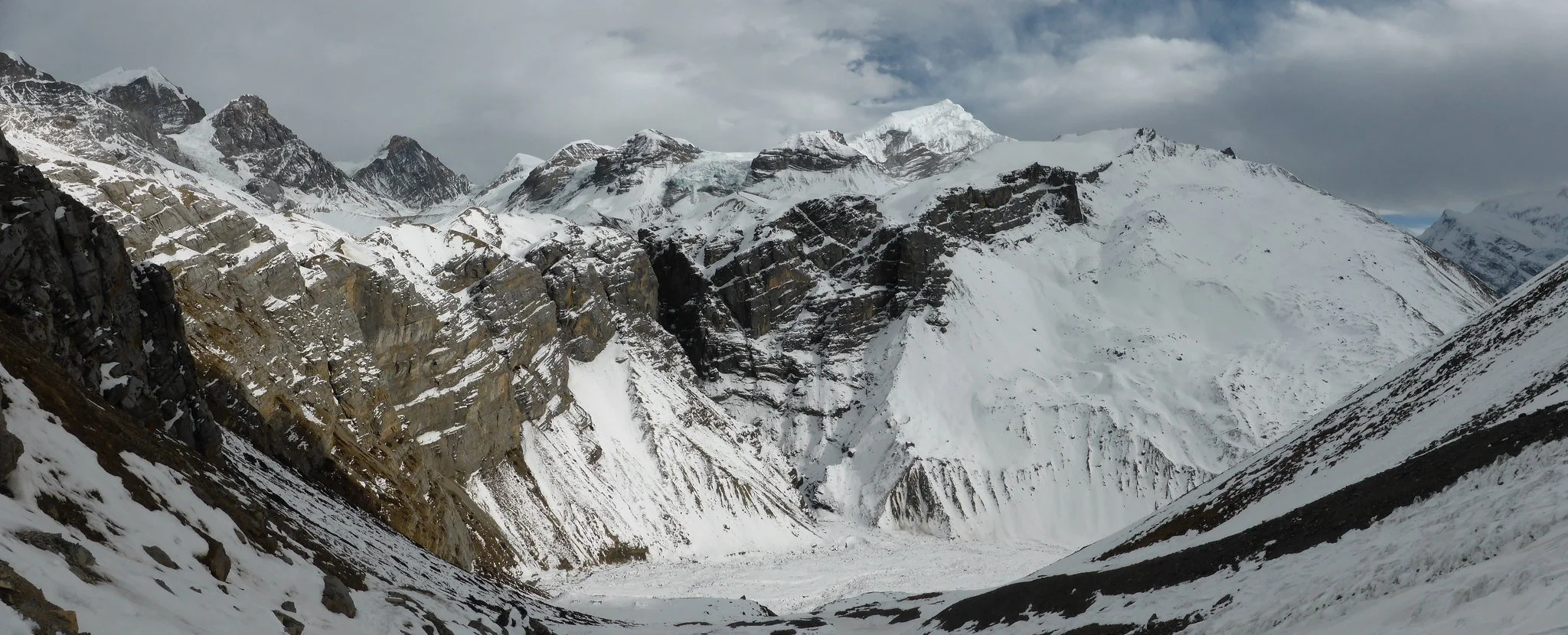13 Essential Things to Know About the Annapurna 5X Summit Challenge – NAMAS Adventure
Chulu range
The Annapurna 5X Summit Challenge is one of the most comprehensive multi-peak expeditions currently offered in the Himalayas. Designed for climbers aiming to progress beyond 6000 meters, this 30-day journey covers five iconic summits in the Annapurna region, each offering a different level of technicality, endurance, and adventure.
If you're planning to join this rare expedition with NAMAS Adventure, here's an in-depth guide covering the 12 most important things you need to know before setting out.
1. Which Peaks Will You Climb in the Annapurna 5X Challenge?
This expedition features five distinct 6000-meter class peaks:
Pisang Peak (6091m): A classic alpine peak ideal for initial acclimatization and confidence-building.
Chulu Far East (6059m): A beginner friendly peak.
Chulu East (6584m): The most technically demanding peak on the itinerary, featuring crevasse fields, steep alpine sections, and a near-vertical snow wall close to the summit.
Chulu West (6419m): Known for its sustained climbs and technical sections, including a vertical headwall at altitude.
Thorong Peak (6144m): A lesser-known gem offering a rewarding summit day with panoramic views of the Annapurna and Mustang regions.
Together, these five summits offer an intense and diverse mountaineering experience.
2. How Technically Demanding Is This Expedition?
The Annapurna 5X Challenge is suitable for beginner to intermediate level climbers with prior high-altitude experience. Chulu East is the most technical of the five, requiring proficiency in glacier travel and steep ascents. Unlike other commercial expeditions that rely heavily on fixed ropes, NAMAS uses guided rope systems on Chulu East to allow flexibility and better management of client safety in real-time conditions.
Chulu West and Far East are graded PD/3 on the Alpine scale, demanding good fitness, endurance, and familiarity with alpine gear.
3. When Should You Join This Expedition?
The best seasons to take on this expedition are Spring (March to May) and Autumn (September to November). These months provide the clearest skies and most stable weather conditions, which are crucial for a safe and successful climb. Winter climbing is possible but comes with greater risks, including unpredictable weather and closed tea houses. So, for the best experience, spring and autumn are your ideal windows.
4. How Long Is the Expedition and What’s the Itinerary?
This is a 30-day expedition that includes travel, acclimatization, technical climbs, and return logistics. It begins with arrival in Kathmandu and transitions to the Annapurna region via road. The summits are tackled in the following order: Pisang → Chulu Far East → Chulu East → Chulu West → Thorong Peak.
Time is built in for acclimatization, training refreshers, and contingency days to account for weather or altitude-related delays.
ITINERARY
Day 1 -2 Arrival, pick up at the airport by Namas staff. Briefings and gear check.
Day 3 Drive to Besi Sahar 5 - 6 hours
Day 4 Drive to Pisang 3300M
Day 5 Acclimatisation and training refresher day in Upper Pisang 3800M
Day 6 Pisang Peak base camp
Day 7 Pisang Peak high camp
Day 8 Summit Pisang Peak - Base camp to Pisang village
Day 9 Contingency day
Day 10 Pisang to Ngawal or Yak-kharka
Day 11 Chulu base camp (Far East and East)
Day 12 Chulu Far East high camp 5343M
Day 13 Chulu Far East Summit 6059M and back to BC
Day 14 Chulu East high camp 6100M
Day 15 Chulu East summit 6584M and back to BC to Manang
Day 16-17 Contingency days
Day 18 Manang arrival or rest day
Day 19 Trek to Ledar to Chulu West BC
Day 20 High camp (Porters up to advanced BC)
Day 21 camp 1 (6100M)
Day 22 Summit and back to high camp
Day 23 Contingency day
Day 24 BC to Ledar to Thorong Phedi
Day 25 Thorong Peak base camp
Day 26 Summit Thorong Peak 6144M and to MuktiNath
Day 27 Muktinath - Jomsom - Pokhara (Via Jeep)
Day 28 Pokhara Rest Day
Day 29 Kathmandu (Afternoon flight or private transport incase of flight cancellation)
Day 30 Departure
5. Who Should Join This Expedition?
This expedition is ideal for:
Climbers aiming to build experience for 7000m+ or technical Himalayan peaks
Adventure athletes with prior 5000m+ climbing experience
Those comfortable with 6–10 hour summit pushes and exposed alpine terrain
This is not a beginner expedition. Participants should be fit, familiar with mountain environments, and prepared for multi-day alpine climbs.
6. How Much Does It Cost and what is included?
For exact expedition quote please check our expedition page (link) which covers almost everything you’ll need for the entire journey:
A certified guide (IFMGA or NMA)
A 1:2 Sherpa-to-climber ratio
16 Weeks of training programs for 6000M from Training Peaks
Namas-branded gear (down jacket, cap, buff)
All trekking and climbing permits
Internal transportation to the trekking trailhead
Meals during the trek and expedition
Accommodation on the trek
All necessary climbing equipment, including tents, satellite phones, and oxygen cylinders
30kg personal weight allowance (with the option for extra porter service for an additional fee)
Welcome/ farewell dinner
This all-inclusive price ensures that you have everything needed for a safe, comfortable, and successful expedition.
7. Are Professional Guides Required?
Yes — and they are non-negotiable on this expedition. Several of the peaks involve technical routes, exposed terrain, and glacier travel. Our guides handle route fixing, risk management, altitude response, and logistics, giving climbers the best chance at a safe and successful summit. Their regional expertise also enhances cultural understanding and route planning.
8. How Is Acclimatization Managed?
A well-designed acclimatization plan is integrated into the itinerary:
Early summit of Pisang Peak helps pre-acclimatize
Multiple rest days between climbs
Overnight stays at high camps before major summit pushes
Built-in contingency days to allow flexibility and prevent altitude-related issues
This gradual ascent schedule ensures safety and improves summit success.
9. What Training Is Required for the Annapurna 5x summit challenge?
To take on this 5x summit challenge, you’ll need to be in great physical and mental shape. While the expedition is accessible to those with intermediate mountaineering skills, proper training is key. Here’s a recommended plan:
- Endurance Training: Long-distance running, hiking with a weighted pack, or cycling will help build the stamina needed for the long days of climbing.
- Strength Training: Focus on building leg and core strength through weight training and hill climbing.
- Technical Skills: Rope handling, crampon use, ice axe arrest (practice on rock or indoor walls if possible)
- Mental Resilience: High-altitude climbing requires mental toughness. Meditation, mindfulness, and visualization techniques can help you stay calm and focused when things get tough.
10. What Gear Is Needed for the Annapurna 5x summit challenge?
Having the right gear is critical for your safety and comfort. Here's what you'll need:
Double-insulated mountaineering boots
Ice axe, crampons, harness, helmet, ascender, belay device
Thermal base layers, down jacket and pants
Glacier glasses/goggles, waterproof gloves
-30°C rated sleeping bag
Backpack (60L+), duffel bag for porters
Hydration system, headlamp, and basic first-aid
NAMAS Adventure also offers gear rentals, ensuring you have top-quality equipment without the need to buy everything yourself.
11. What Food and Water Are Provided During the Expedition?
Food is an important part of your expedition, and NAMAS Adventure ensures you’re well-fed throughout the journey. On trekking days, meals are prepared at local tea houses, and while climbing, our Sherpa chefs will prepare nutritious meals to keep you energized. Staying hydrated is crucial, so make sure to drink 4-6 liters of water a day. Water is purified from natural sources or purchased from tea houses, and we provide hydration tablets to ensure your safety.
12. What Trip Insurance Is Required for the Expedition?
Comprehensive travel insurance is a must. Make sure your policy covers:
- Emergency evacuation (including by helicopter if necessary).
- Medical coverage for altitude sickness or injuries.
- Trip cancellation or interruption.
- Repartations
It’s also important that your insurance covers helicopter evacuation, as it could be essential in case of an emergency.
13. Which Other High-Altitude Peaks Can You Aim for After the 5X Summit Challenge?
Successfully completing the Annapurna 5X positions you for more advanced climbs. Logical next steps include:
Expeditions in the Karakoram or South America
The physical and technical experience gained here lays a strong foundation for 7000m+ Himalayan climbs and guided alpine-style expeditions worldwide.
Conclusion
The Annapurna 5X Summit Challenge is not just an expedition — it’s a personal and physical evolution. Over 30 days, you’ll climb five major 6000M+ peaks, gain critical alpine experience, and explore some of Nepal’s most breathtaking landscapes.
Whether you're preparing for your first 7000er or building toward the 8000M club, this challenge offers everything you need: altitude, technical exposure, skilled guiding, and remote Himalayan beauty.
Are you ready to take on the challenge? NAMAS Adventure will be with you every step of the way, ensuring a safe and successful journey. For more information or to book your spot, reach out to us at bookings@namasadventure.com.
Live Your Story.
NAMAS Adventure

